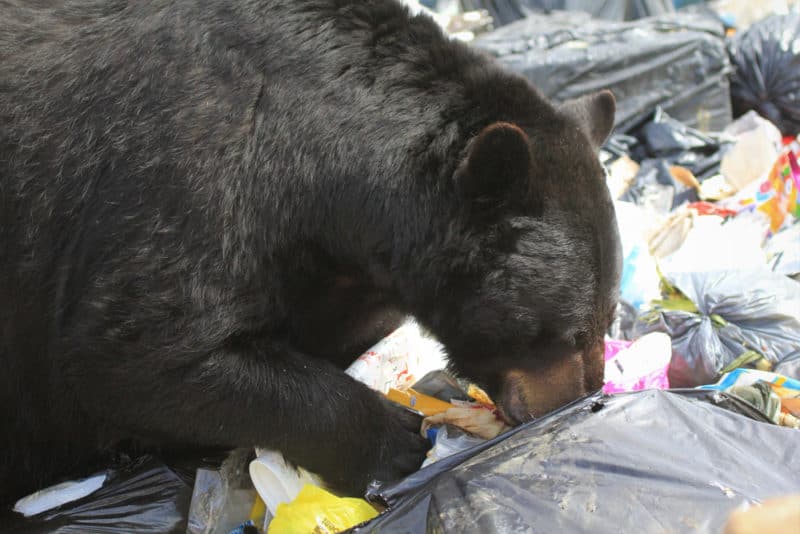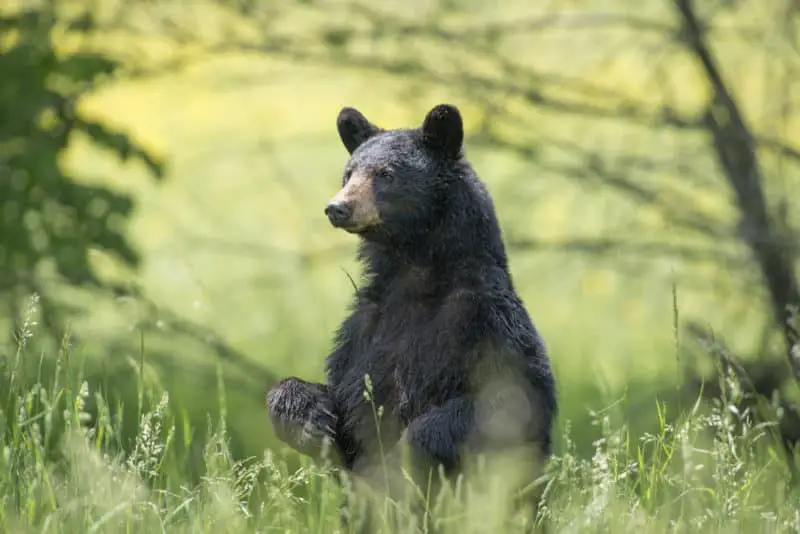Are there bears in Georgia? The answer is yes. Georgia is home to a population of American black bears. This is the only bear species native to the state. According to the Georgia department of natural resources, although black bears are the most common bear species in North America, they were nearly expatriated from the state by the 1930s. Large-scale habitat loss and unregulated hunting were to blame.
Today though, the Georgia DNR has achieved a conservation success story. Through sound wildlife management practices, they have restored a thriving population of around 4100 black bears to the state. Per their website, they consider the black bear to be a symbol of Georgia’s natural diversity.
Black bears in Georgia
Most of Georgia’s black bears are concentrated in three areas of the state, with some exceptions. They will range over larger areas in search of food in times of scarcity. Also, sometimes young male bears will travel hundreds of miles to establish their own home range.
Excluding the above exceptions, Georgia’s black bear population is concentrated mainly in the North Georgia mountains, the Ocmulgee River drainage system, which is in central Georgia, and the area in and around the Okefenokee Swamp which is on Georgia’s southern border. See
The northern Georgia black bear population currently stands at around 3000 animals. The next two regions have a smaller number of bears. They are around 300 bears in the central and 800 bears in the southern regions, respectively. See

General black bear characteristics
There are 16 distinct black bear sub-species, and they all reside in North America. The United States has 2 other bear species, which are brown/grizzly bears and polar bears. Both of these reside in Europe and Asia, as well as North America.
Adult black bears vary from 50 to 85 inches long from the tip of the nose to the tail. Their average height is around 30 inches at the shoulder. The normal black bear’s weight range is from 140 to 400 pounds. However, adult males can be up to 70% larger than females, and some giant-sized individuals weigh over 800 pounds. The heaviest black bear ever harvested came from Pike County, Pennsylvania. It weighed 875 pounds.
Even though they are named black bears, their color can vary from black. Some black bears are blue-grey, cinnamon, brown, and blue-black, and on infrequent occasions, a black bear can even be white. Although most Georgia bears are black, a small percentage of them are tan or cinnamon-colored. Some black bears have a V-shaped white patch on their chest.
They have long brown snouts with a broad nose pad and large nostrils, short tails, and small brown eyes, although their eyes are blue at birth. Black bears don’t have a shoulder hump like brown bears or grizzly bears do. In areas that both species inhabit, the hump, or the lack thereof, is a distinguishing feature. Any wild bear in Georgia will be a black bear, though.
There’s some debate over how well black bears see. However, there’s no denying that they have exceptional auditory and olfactory senses. Their hearing is twice as sensitive as that of a human. What’s more, their sense of smell is particularly strong in that they can smell up to seven times better than a bloodhound.
Although black bears appear to be slow and ponderous as they forage for food, they have the ability to run 30 to 35 miles per hour in short bursts and can climb straight up a hundred feet of tree in about 30 seconds. See
Black bears are omnivorous. Their diets have been documented to consist of up to 96% plant material such as nuts, acorns, fruit, berries, grasses, and forbs. They also feed on ants, larvae, and small mammals.
At around three to four years old, a black bear is mature enough to mate. Females usually only get pregnant every other year. This depends on food sources because if the food is scarce, they may wait an additional year or two until they mate again. Like in other bear species, female black bears have delayed implantation, which means that the embryo(s) do not attach to their uterus until fall when they go to their winter-time hibernation period. Black bears have1 to 4 cubs, which tend to stay with their protective mothers until they are a year and a half to two years of age. See
In the wild, individual bears live up to 20 years.
Living with black bears
Sometimes people move into bear country without taking into consideration the complications that having bears close by presents for both them and the bears. As the state of Georgia’s human population increases, so does the potential for human-bear conflicts. Bears from Georgia’s central population occasionally end up in the Atlanta metro area, for example. See
In fact, Kaitlin Goode is a wildlife biologist and also the manager of the Georgia DNR’s Urban Wildlife Program, which deals with educating the public on and dealing with wildlife related issues in the Atlanta metro area. One of the issues they deal with is human-bear conflicts. See
Living in close proximity to bears comes with a set of complications that a homeowner would not otherwise have. Black bears have an excellent sense of smell and can smell food up to 20 miles away. It takes some planning and effort to keep problem bears from seeking out your residence for a free meal.
Once they have eaten human-provided foods, they’ll return looking for more. A human habituated bear is a danger to all humans and to itself. It will either have to be relocated or euthanized as a matter of public safety.

Bear wise
Adam Hammond, the state bear biologist with the Georgia DNR, encourages Georgia residents who live in bear country to become bear-wise.
Bear wise is an education program designed by bear biologists from each of the 15-member wildlife agencies that belong to the Southeastern Association of Fish and Wildlife Agencies. See The
The bear wise program encourages homeowners in bear country to adhere to the following 6 basic principles to avoid human-bear conflicts and bear-caused property damage.
- NEVER FEED OR APPROACH BEARS: Feeding bears (intentionally or unintentionally) trains them to approach homes and people for more food. Bears will defend themselves if a person gets too close, so don’t risk your safety and theirs!
- SECURE FOOD, GARBAGE, AND RECYCLING: Food and food odors attract bears, so don’t reward them with easily available food or garbage.
- REMOVE BIRD FEEDERS WHEN BEARS ARE ACTIVE: Birdseed and other grains have a high calorie content making them very attractive to bears. The best way to avoid conflicts with bears is to remove feeders.
- NEVER LEAVE PET FOOD OUT: Feed outdoor pets portion sizes that will be completely eaten during each meal and then remove leftover food and food bowl. Securely store these foods, so nothing is available to bears.
- CLEAN AND STORE GRILLS: After you use an outdoor grill, clean it thoroughly and make sure that all grease and fat are removed. Store cleaned grills and smokers in a secure area that keeps bears out.
- LET NEIGHBORS KNOW: Share news with your friends and neighbors about recent bear activity and how to avoid bear conflicts. Bears have adapted to living near people; are you willing to adapt to living near bears?
I would add that human food sources such as orchards, gardens, beehives, and chicken coops should be surrounded by an electric fence.
It’s also not a good idea to park a vehicle outside that has remnants of fast food in it. A black bear can peal the door from your car to get at whatever human food it can smell inside.
Gerald Hodge has founded an organization called Appalachia Georgia Friends of the Bears, Inc, said his mission is to reduce negative bear/human interactions through proactive education. Appalachia Georgia Friends of the Bears partners with Bear wise to educate Georgia’s citizens on the dos and don’ts of living in bear country.
Bear hunting in Georgia
Bear hunters in Georgia are allowed to take up to two bears per hunting season. However, only one of the two may be harvested in the central or southern regions. It’s also unlawful to kill a female with cubs. The taking of bears under 75 lbs is also illegal. See here for a complete list of bear hunting regulations in Georgia.
Recent Posts
The only venomous snakes in Washington State are Northern Pacific Rattlesnakes. The Northern Pacific Rattlesnake (Crotalus oreganus oreganus) is a sub-species of the Western Rattlesnake. Anyone...
Skunks are not classified as true hibernators. But they go into a state of torpor when the weather gets cold. Skunks are light sleep hibernators, along with opossums, bears, and raccoons. ...

